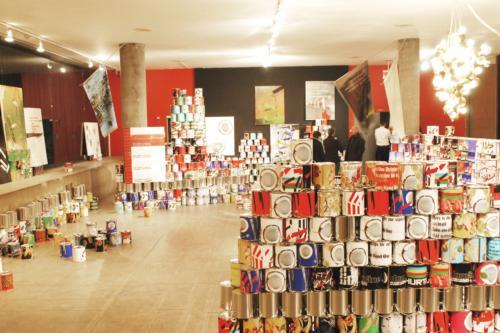
News
Pro-Palestine Encampment Represents First Major Test for Harvard President Alan Garber

News
Israeli PM Benjamin Netanyahu Condemns Antisemitism at U.S. Colleges Amid Encampment at Harvard

News
‘A Joke’: Nikole Hannah-Jones Says Harvard Should Spend More on Legacy of Slavery Initiative

News
Massachusetts ACLU Demands Harvard Reinstate PSC in Letter

News
LIVE UPDATES: Pro-Palestine Protesters Begin Encampment in Harvard Yard
Coconuts, Lights Adorn New Exhibit

Chandeliers of coconuts and glowing light bulbs dangled from the ceiling as “Guyton\Walker: Empire Strikes Back,” an installation by artists Wade Guyton and Kelley Walker, opened for a five-week exhibition at the Carpenter Center for the Visual Arts last night.
In front of a crowd of students and faculty, Guyton and Walker held a public conversation with Scott Rothkopf ’99—a senior editor at ArtForum, a national magazine—on the process of making art and the dynamics of collaborating with another artist.
Professor of Visual and Environmental Studies (VES) Stephen Prina introduced the artists with a presentation that included philosophy references and an impromptu piano performance.
“Thank you, Stephen, for reminding us why God created tenure,” said Rothkopf, also a Ph.D. candidate in the Department of History of Art and Architecture.
Though the exhibit lacks an official curator, Prina said he became the “curator by proxy” after he proposed the idea last summer.
According to Prina, Guyton was immediately enthusiastic, although it wasn’t until recently that the exhibition came to fruition.
“Last week we made all the paintings in the studio upstairs,” Guyton said.
Earlier this week, students in Prina’s VES course, entitled “Loitering,” used their class time to help the artists arrange paint cans into clusters, walls, and columns.
The colorful paint cans share installation space with a series of paintings set in rows along the gallery walls. The paintings incorporate layers of silk-screened images, most of which were produced with a flatbed scanner.
Most of the canvasses feature the logo of Ketel One, a brand of Vodka. This logo frequently shares the canvas with colored rectangles, images of sliced fruit and steak knives, and Swiss advertisements.
The coconut chandeliers and drooping flags are the final elements of the installation.
Yesterday, Guyton and Walker particularly relished that their installation was housed in the only building in North America designed by modernist architect Le Corbusier.
“It’s rare to be able to work in a building like this,” Guyton said. “If Corbusier meant [for the room] to be a gallery space, he was actually quite hostile.”
The room is asymmetrically shaped, with recessed walls that are not easy to illuminate, and thick concrete pillars that impede sight lines.
Responding to Corbusier’s apparent antagonism, Guyton said, “It’s been fun to be antagonistic back.”
A teaching fellow in the VES department, Carlin E. Wing ’02, said, “This exhibition works well because it’s in conversation with the architecture rather than trying to talk around it.”
Guyton and Walker are not big names in the art world, which is one reason Prina wanted to bring them to Harvard, he said.
“I think VES should be presenting work that is speculative, where the judgement call is still out,” Prina said. “It’s important for the Carpenter Center to be a laboratory for the arts.”
The installation will be on display in the main gallery of the Carpenter Center until April 20th.
Want to keep up with breaking news? Subscribe to our email newsletter.
